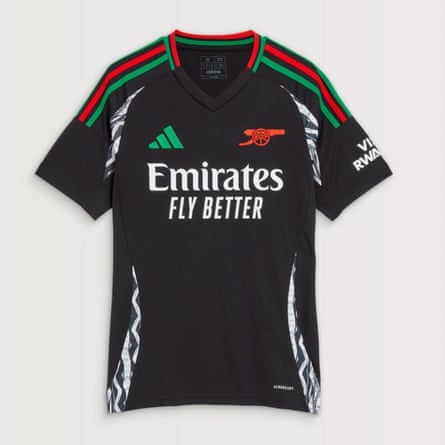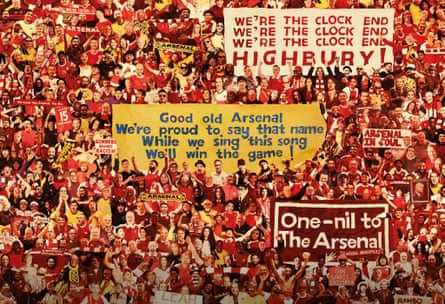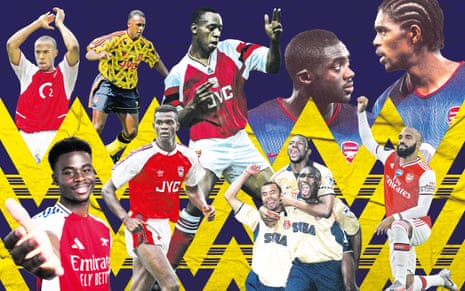In July, Arsenal football club launched its new alternative away kit for the forthcoming 2024-25 season. The shirt, made by Adidas, is designed by Foday Dumbuya, founder of the London menswear brand Labrum, and it pays specific homage to the club’s African fanbase, and to the players – Nwankwo Kanu, Kolo Touré and others – whose deeds are woven into the north London club’s recent history. Using black, red and green details to refer to the pan-African flag, Dumbuya – who was born in Sierra Leone and moved to London at the age of 12 – intended the design to celebrate what he sees as Arsenal’s unique place in the multicultural capital and its appeal to fans, including Spike Lee and Jay-Z, worldwide. Dumbuya’s design is a natural successor to the club’s green, black and gold “Jamaica” pre-match kit, launched at the Notting Hill carnival in 2022.
That heritage and spirit is also the focus of a new book, Black Arsenal, published for the start of the season, created and co-edited by Clive Chijioke Nwonka, associate professor of film, culture and society at University College London (UCL), and writer Matthew Harle. With contributors that range from cultural studies stars to pioneering former players Ian Wright and Paul Davis, the book examines how the club has become an authentic expression of integrated Black British culture. In a week in which the ugly face of racial conflict has been a dispiriting reality, it’s a reminder of the great strides this country has made in moving beyond such tensions, with the national game and the global brand of the Premier League at the front edge of that advance.

It is Nwonka’s argument that Arsenal has been pivotal in demonstrating that hard-won – and too easily lost – joy and ease. When I met him 10 days ago in his office at UCL, he had just picked up the first copy of his beautifully illustrated book. His original plan for it, he says, had been a kind of dense intellectual tome about cultural identity, with all the appropriate references to French poststructuralists and the revolutionary writer Frantz Fanon. As it evolved, however, he realised that the story could be better told, for example, through shared memories of those on-field French philosophers of the unbeaten Arsenal “Invincibles” side, captained by Patrick Vieira, and through examination of the struggles and tragedies of club legends such as David “Rocky” Rocastle, and the Arsenal-loving boxer Michael Watson, and their relation to the wider culture and art and music of London.
In some ways, I say to him, the book is the tale of two murals. The first was in place on the North Bank of the old Highbury stadium at the launch of the Premier League in 1992. “I remember as a kid,” Nwonka recalls, “the first week of the Premier League season there were all these half-rebuilt stadiums because of the Taylor report [into ground safety after the Hillsborough disaster]. Of course, no one wants to watch a building site on Sky Sports – so the idea came up that you cover it up with these illustrations of your imagined fanbase.” The original North Bank mural was an artist’s impression of a sea of white faces, with red and white scarves. “The instinctive response was: ‘That isn’t us,’” Nwonka recalls. The Black Arsenal striker Kevin Campbell, who had come up through the club’s youth teams, publicly asked: “Where are my brothers here?” And the mural was changed – to an image of a multiracial fanbase that was a true reflection, not just of the fans inside the stadium, but of walking down the nearby Holloway Road.
By the time a second mural was created for the new Emirates stadium in 2023, those questions seemed entirely beside the point: Arsenal fans were obviously everybody. The London artist Reuben Dangoor, who became famous with portraits of Grime artists, called his mural Found a Place Where We Belong.

Photograph: Suki Dhanda
All football fans, of course, believe their club has a monopoly of tradition and virtue. Reading Nwonka’s book as a lifelong fan of Aston Villa – a club that has long tried to live up to the spirit of its late lamented poet laureate Benjamin Zephaniah – I inevitably found myself asking if these rich community ties are not more universal than Nwonka suggests. He accepts that many other clubs have become something of an advert for successful integration, but insists that Arsenal stands tallest in that company. And he has objectivity on his side. Though he goes often to Arsenal games, these days with his young nephew, Liverpool’s result is still the first he looks for.
“Among my first receptors as a young Black person was first opening a football sticker album and seeing all these white players and in among them a few Black players. And primary among them was John Barnes,” he says. When Nwonka gave a talk on the subject of his book at the Barbican, he provoked a few boos from his partisan Gooner audience by putting up an image of the Liverpool and England legend as his first slide. He is unrepentant. “You can’t really understand Ian Wright and Black Arsenal without first understanding John Barnes,” he says. “When I was at school, he represented to all Black people a signifier for excellence and pride and a defence against racist comments.”
Back in the mid-80s, when Barnes was in his prime, “Englishness was still a contested term in relation to Black people,” Nwonka says. “There were other prominent Black sporting figures at the time, such as Linford Christie or Frank Bruno. But John Barnes was getting into an idea of Englishness, not Britishness. He wasn’t holding up a union jack, he was holding the St George’s Cross.” When Barnes did his famous rap for New Order’s World in Motion anthem for the World Cup in 1990, he concluded without equivocation: “I’m the England man.” You are reminded that only eight years earlier, when West Bromwich Albion’s Black centre-forward Cyrille Regis made his international debut, he opened a letter in the dressing room before the match that contained a bullet and a note that read: “If you put your foot on our Wembley turf you’ll get one of these through your knees.”
“I think that the current dominant idea is that Italia 90 led to a massive change in football in terms of culture,” Nwonka says. “I say in response: ‘Yes, Gazza and all that was important.’ But I always point to 1989 and Michael Thomas’s title-winning goal for Arsenal at Liverpool as the moment when we realised that English football could be packaged as the [global] spectacle it has become.”
If the launch of the Premier League prompted that inclusive, outward-looking, all-the-world-is-here sentiment, then the FA Cup final of 1990 showcased its pre-eminent star. Unlike Barnes, who had quite a rarefied childhood, the son of a colonel in the Jamaican army, Wright was a product of tough south London housing estates. He was a regular on the uncompromising terraces at Millwall. Nwonka recalls how, as a player, he literally heard Wright coming. “I grew up on an estate at the back of Wembley stadium,” he says. “The coaches of cup final teams would sometimes come past our window on a shortcut to the stadium car park. I remember being in my sister’s bedroom in 1990 and we had a small TV watching the cup final [between Crystal Palace and Manchester United]. I watched Ian Wright come on from the subs’ bench and score those two incredible goals and hearing this huge roar from the stadium and just thinking: ‘Who is this guy?’”

Wright, when he came to Arsenal to join his childhood friend Rocastle the following year, was a gamechanging character, huge-hearted, insistently himself (in his contribution to the book, Wright recalls how he refused to wear a suit to his first press conference at the club – “that wasn’t me”) and an instant idol to young Black Londoners of Nwonka’s generation. “He spoke in a vernacular you might hear at the barbershop or the local playground,” Nwonka says. “And very quickly, you saw not only Black fans but white fans wearing a shirt with ‘Ian Wright’ on the back. There was something transcendent about that. He was the first poster boy for the Premier League.” Nwonka’s book examines how the Arsenal generation of Black players that preceded Wright – Raphael Meade and Davis and Thomas – allowed him to achieve that stardom. And how he in turn set the stage for Vieira and Thierry Henry and Bukayo Saka now.
Wright’s impact, Nwonka says, went far beyond his goal-scoring. “With his emergence in the Premier League came a new visual culture. All of a sudden, for example, [in 1992] you had this ‘Can I Kick It?’ Nike advert, [featuring Wright and a hip-hop soundtrack from the New York-based rappers A Tribe Called Quest] that immediately represented to me and to people around me a much sharper representation of the Black, urban working-class masculinity.”

Black Arsenal is alive to all the ways the energy that flowed from Wright became part of the club’s DNA, strengthened through the Arsène Wenger years by the arrival of Black African stars such as Kanu and global superstars such as Henry. As a result, he says, integration is not “a Black history month thing” that you might see at other clubs and organisations, but a lived reality, celebrated each match day, in the stadium and far beyond.
after newsletter promotion
“I think there is something about how they produce players from the youth teams at Arsenal that also allows for the kind of natural multiculture in the stands,” he says. “Of course, I’ve got a little bit of criticism from some quarters. One person, when I first posted about the Black Arsenal idea, wrote to me to say: ‘I’ve been going to Arsenal since the 1970s. I don’t see race; I watch football.’ I thought to myself: ‘Well, I’m not going to sit here and tell someone whether they should or shouldn’t see. But have you stopped and thought that maybe the reason that you don’t see race when you go to Arsenal is that Arsenal has normalised racial difference in a way that some other clubs didn’t? And that may be an important thing to recognise?’” In the book, the academic Paul Gilroy has a simple and resonant term for that experience, one too easily forgotten in our extremist times: everyday conviviality.
Of course, Nwonka’s book does not shy away from the racism that players, including Wright, faced. It was one of the reasons that he invited several contributors to the book, rather than writing all of it himself. Friend and Arsenal fan David Forrest writes about a notorious game that Arsenal played at Barnsley when all their Black players were subjected to vicious abuse. Forrest, a professor at Sheffield University, recalls how that night opened his eyes to another Britain. Wright has recalled how one Barnsley fan, 25 years later, contacted him to apologise for his part in that racist chanting, saying that it shamed him to this day.
Naturally, sporting brands are not beyond exploiting such histories for profit; does Nwonka think there is a danger that Adidas and Nike and the rest are not simply cynically trading on some of that history for their own gain?
“With things like the Arsenal Africa shirt or the Jamaica shirt,” he says, “they’ve been quite open about the fact that they recognise that there was a consumer base that will find the resonance in something that pays homage to Afro-Caribbean culture. But I mean, I’ve been going to the Notting Hill carnival since I was four years old. And you would always see Arsenal shirts there all the time, rather than QPR shirts, or Brentford shirts, or Fulham or Chelsea. But what some brands often do is invest in what they imagine to be Black culture, whereas Black Arsenal, I believe, begins with Black people.”
He writes in the book about the introduction of the club’s new £105m signing last year, Declan Rice, in some ways the embodiment of an older “white working-class” tradition in football, who was presented to his new fans in a social media film involving Stormzy and Wright, among others. “I think working class is multicultural,” Nwonka says. “And if you can augment the news of a signing with music and visual elements that appeal to Black youth culture, that will, by extension, naturally appeal to the multiracial experience as well.”

We are speaking in times of rising racial tension. Does Nwonka think that football is the place where we can remind ourselves that multiculturalism works?
“When it comes to thinking about politics and race, we can’t always rely on culture as a way to remedy deeper structural questions,” he says. “Having particular players or particular footballing cultural moments as a point of identification is immense. But it can’t be a deliberate or a forced thing.”
He suggests that the progress that has been made requires constant affirmation – not just warm words – reflecting some of the messages of James Graham’s Gareth Southgate drama, Dear England, and the racist abuse directed at Saka after he missed a crucial penalty. “You look at the Euros of 2021,” Nwonka says. “There we were, you know, all celebrating our Black players against Germany and against Denmark. And using that moment as evidence of this integrated multicultural nation. And then all it took was another game and 12 yards from the penalty spot and we were back to square one again.”

Comments (…)
Sign in or create your Guardian account to join the discussion